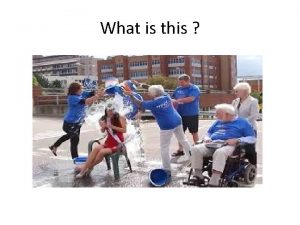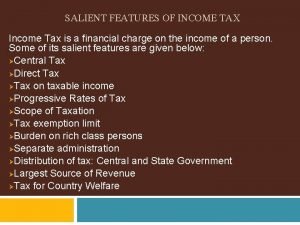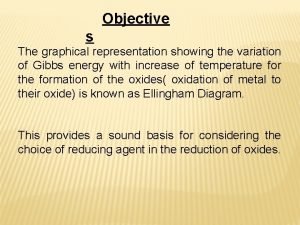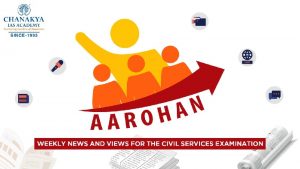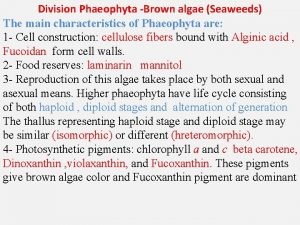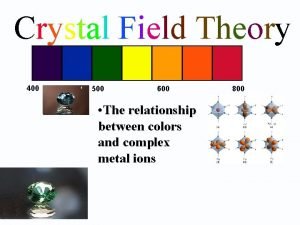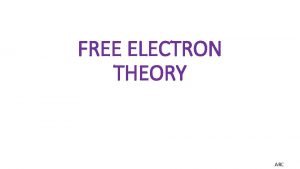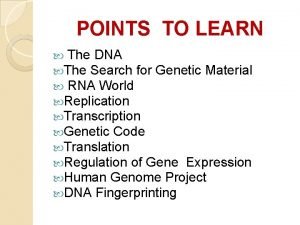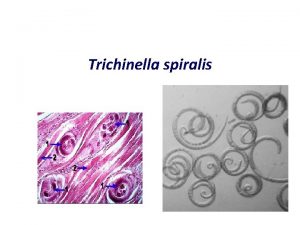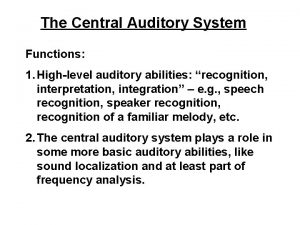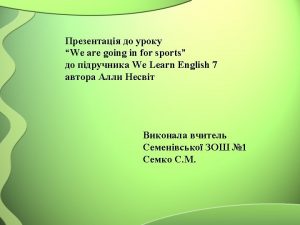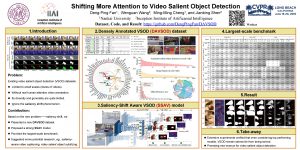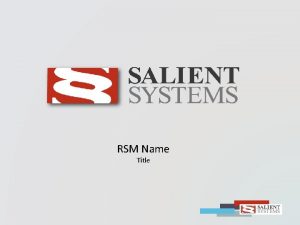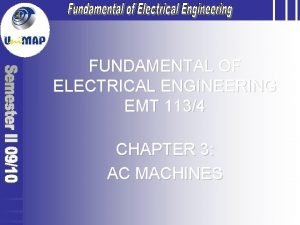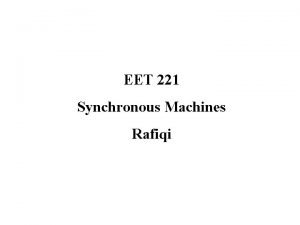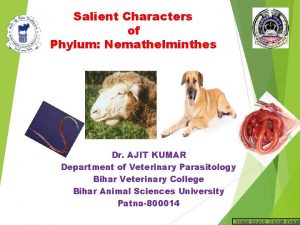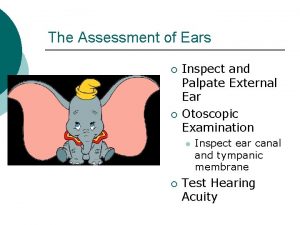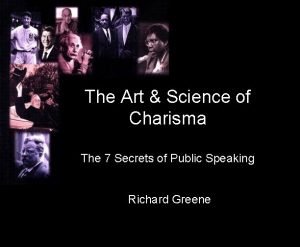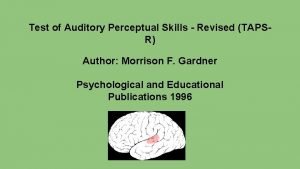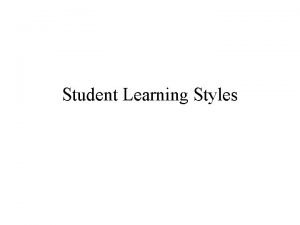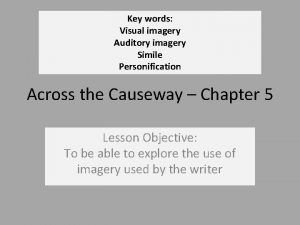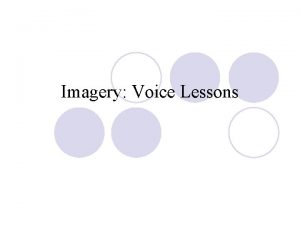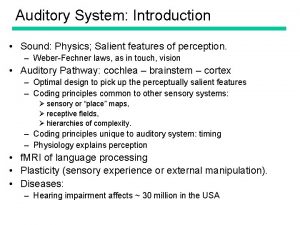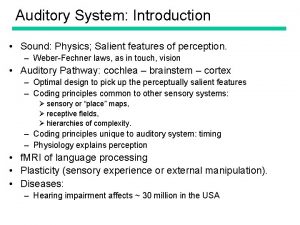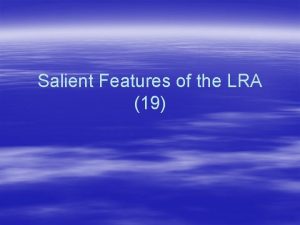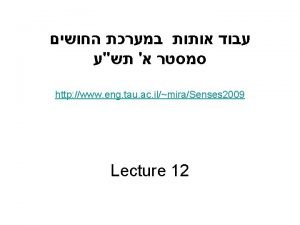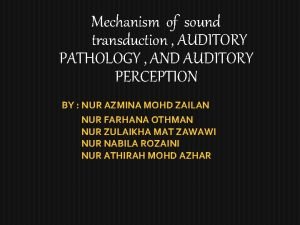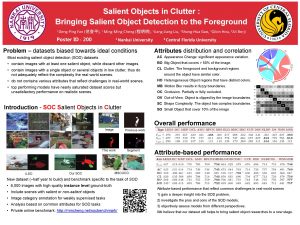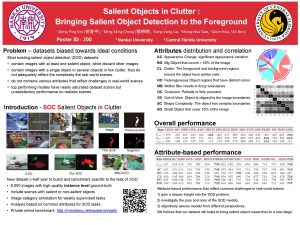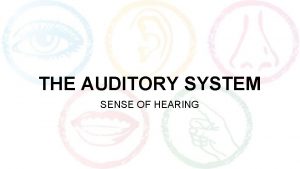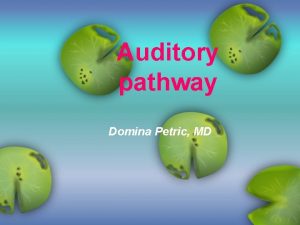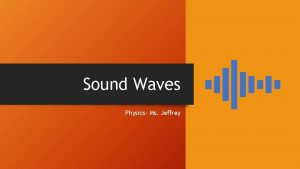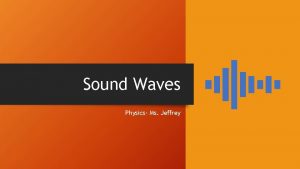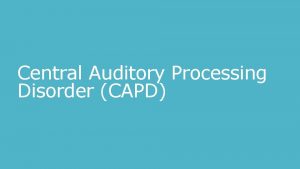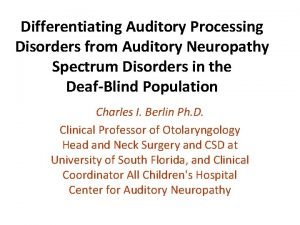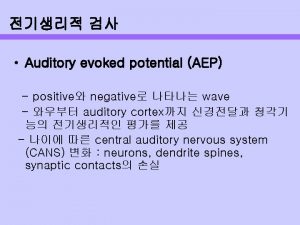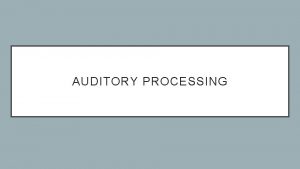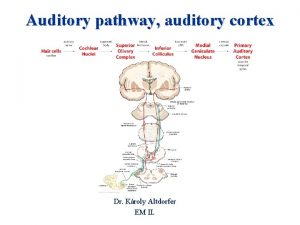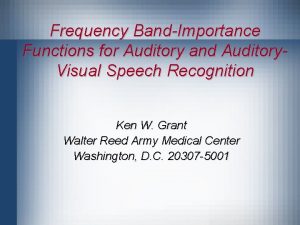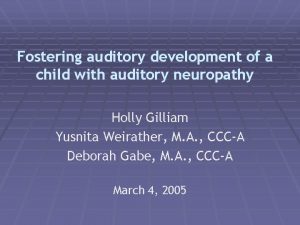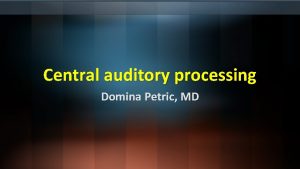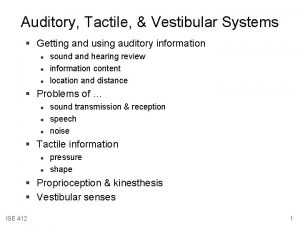Auditory System Introduction Sound Physics Salient features of






































- Slides: 38

Auditory System: Introduction • Sound: Physics; Salient features of perception. – Weber-Fechner laws, as in touch, vision • Auditory Pathway: cochlea – brainstem – cortex – Optimal design to pick up the perceptually salient features – Coding principles common to other sensory systems: Ø sensory or “place” maps, Ø receptive fields, Ø hierarchies of complexity. – Coding principles unique to auditory system: timing – Physiology explains perception • f. MRI of language processing • Plasticity (sensory experience or external manipulation). • Diseases: – Hearing impairment affects ~ 30 million in the USA

Sound: a tiny pressure wave • Waves of compression and expansion of the air – (Imagine a tuning fork, or a vibrating drum pushing the air molecules to vibrate) • Tiny change in local air pressure: – Threshold (softest sounds): 1/1010 Atmospheric pressure – Loudest sounds (bordering pain): 1/1000 Atmospheric pressure • Mechanical sensitivity

Pressure Pitch (Frequency): heard in Octaves Tim e • PITCH: our subjective perception is a LOGARITHMIC FUNCTION of the physical variable (frequency). Common Principle • Pitch perception in OCTAVES: “Equal” intervals actually MULITPLES. • Two-tone discrimination: like two-point discrimination in the somatosensory system. Proportional to the frequency (~ 5%). • Weber-Fechner Law • WHY? Physiology: “place” coding for frequency coding in cochlea up to cortex; sizes of receptive fields. Just like somatosensory system

Pressure Complex sounds: Multiple frequencies Pressure Tim e “wa” Tim e • Natural sounds: – multiple frequencies (music: piano chords, hitting keys simultaneously; speech) – constantly changing (prosody in speech; trills in bird song) • Hierarchical system, to extract and encode higher features (like braille in touch, pattern motion in vision)

Loudness: Huge range; logarithmic • Why DECIBELS ? • LOUDNESS perception: also LOGARITHM of the physical variable (intensity). – Fechner (1860) noticed: “equal” steps of perceived loudness actually multiples of each other in intensity. Logarithmic – Defined: log scale Decibels: – 10 log 10 (I / Ith) – Threshold: 0 d. B: (1/1010 atmospheric pressure) – Max: 5, 000 larger in amplitude, 1013 in power – HUGE range. • Encodes loudness • Adapts to this huge range

Timing: Used to locate sound sources • Not PERCEIVED directly, but critical for LOCATING sources of sound in space: – Interaural Time Difference (ITD) as a source moves away from the midsaggital plane. – Adult humans: maximum ITD is 700 microseconds. – We can locate sources to an accuracy of a few degrees. This means we can measure ITD with an accuracy of ~ 10 microseconds – Thus, auditory system needs to keep track of time to the same accuracy. – Unique to auditory system (vs. visual or touch)

Auditory System: Ear Principles of Neural Science (PNS) Fig 30 -1

Middle Ear: Engineering; diseases • Perfect design to transmit tiny vibrations from air to fluid inside cochlea • Stapedius muscle: damps loud sounds, 10 ms latency. • CONDUCTIVE (vs. SENSORINEURAL) hearing loss – Scar tissue due to middle-ear infection (otitis media) – Ossification of the ligaments (otosclerosis) • Rinne test: compare loudness of (e. g. ) tuning fork in air vs. placed against the bone just behind the auricle. • Surgical Principles of Neuralintervention Science, Chapter 30 usually highly effective

Inner ear: Cochlea • 3 fluid-filled cavities • Transduction: organ of Corti: 16, 000 hair cells, basilar membrane to tectorial membrane PNS Fig 30 -2

Basilar Membrane • Incompressible fluid, dense bone (temporal). PNS, Fig 30 -3

Basilar Membrane: tonotopy, octaves • Thick & taut near base • Thin & floppy at apex • Piano strings, or xylophone (vibraphone). • Tonotopic PLACE map • LOGARITHMIC: 20 Hz -> 200 Hz -> 2 k. H -> 20 k. Hz, each 1/3 of the membrane • Two-tone discrimination • Complex sounds • Timing PNS Fig 30 -3

Organ of Corti

Organ of Corti • Inner hair cells: single row, ~3500 cells, stereocilia free in fluid. • Outer hair cells: 3 (to 4) rows, totalling ~ 12000, stereocilia embedded in gelatinous overlying tectorial membrane • From basilar membrane vibration, adjacent hair cells differ ~0. 2% in CHARACTERISTIC FREQUENCY (freq at which most sensitive). (Piano strings: 6% apart) PNS Fig 304

Transduction: inner hair cells • Inner hair cells: MAIN SOURCE of afferent signal in auditory (VIII) nerve. (~ 10 afferents per hair cell) • Outer hair cells: primarily get EFFERENT inputs. Control stiffness, amplify membrane vibration. (5, 000 X range) PNS Fig 3010

Auditory System: Hair Cells Auditory system AND Vestibular system (semicircular canals) PNS Fig 31 -1

Auditory System: Hair Cells • Force towards kinocilium opens channels & K+, Ca 2+ enter, depolarizing cell by 10 s of m. V. Force away shuts channels. • Tip links (em): believed to connect transduction channels (cation channels on hairs) PNS Fig 31 -2, 31 -3

Auditory System: Hair Cells • Force towards kinocilium opens channels & K+, Ca 2+ enter, depolarizing cell by 10 s of m. V. Force away shuts channels. • Tip links (em): believed to connect transduction channels (cation channels on hairs) • Cell depolarized / hyperpolarized – frequency: basilar membrane – timing: locked to local vibration – amplitude: loudness • Neurotransmitter (Glu? ) release • Very fast (responding from 10 Hz – 100 k. Hz i. e. 10 msec accuracy). PNS Fig 31 -2

Hair Cells: Tricks to enhance response: • To enhance frequency tuning: – Mechanical resonance of hair bundles: Like a tuning fork, hair bundles near base of cochlea are short and stiff, vibrating at high frequencies; hair bundles near the tip of the cochlea are long and floppy, vibrating at low frequencies. – Electrical resonance of cell membrane potential • Synaptic transmission speed: – Synaptic density: for speed ? • Adapting to large displacement: – Ca 2+-driven shift in tip link insertion site, myosin motor on actin in hair bundles. PNS Fig 31 -5

Cochlear prosthesis • Most deafness: SENSORI -NEURAL hearing loss. • Primarily from loss of cochlear hair cells, which do not regenerate. • Hearing loss means problems with language acquisition in kids, social isolation for adults. • When auditory nerve unaffected: cochlear prosthesis electrically stimulating nerve at correct tonotopic site. PNS Fig 30 -18

Auditory Nerve (VIII cranial nerve) • Neural information from inner hair cells: carried by cochlear division of the VIII Cranial Nerve. • Bipolar neurons, cell bodies in spiral ganglion, proximal processes on hair cell, distal in cochlear nucleus. PNS Chapter 30

Auditory Nerve (VIII): Receptive fields • Receptive fields: TUNING CURVE from hair cell • “Labeled line” from “place” coding. • Note: bandwidths equal on log frequency scale. Determines two-tone discrimination.

Auditory Nerve (VIII): Receptive fields • Receptive fields: TUNING CURVE from hair cell. • “Labeled line” from “place” coding. • Note: bandwidths equal on log frequency scale. Determines two-tone discrimination. • Loudness: spike rate (+ high-threshold fibers) • Phase-locking to beyond 3 k. Hz • Match: to frequency, loudness and timing Characteristic freq (k. Hz)

Auditory System: Central Pathways • Very complex. Just some major pathways shown. PNS Fig 30 -12

Auditory System: Central Pathways General principles. – Parallel pathways, each analysing a particular feature – Streams separate in cochlear nucleus: different cell types of project to specific nuclei. Similar to “what” and “where” – Increasing complexity of responses – Extensive binaural interaction, with responses depending on interactions between two ears. Unilateral lesions rarely produce unilateral deficits.

Cochlear Nucleus: • VIII nerve: branches -> 3 cochlear nuclei. – Dorsal Cochlear Nucleus (DCN) – Posteroventral Cochlear Nucleus (PVCN) – Anteroventral Cochlear Nucleus (AVCN) • Tonotopy (through innervation order) • Start of true auditory feature processing. – Distinct cell classes: stellate (encode frequency), bushy (encodes sound onset) – Different cell types project to different relay nuclei. PNS Fig 30 -13 PNS Fig 3014

Auditory System: Central Pathways

Superior Olive: Locates sound sources • Medial Superior Olive: interaural time differences: – Delay Lines: Coincidence detector (accurate up to 10 ms). – Timing code converted to place code. – Tonotopic, match across frequencies (better at low frequencies) • Multiple sclerosis -> sound sources seem centered: PNS Fig 30 -15

Superior Olive: locates sound sources • Lateral Superior Olive: interaural intensity differences. • Works best at high frequencies, the head casts a better shadow. • Again, organized tonotopically to match across frequencies. Principles of Neural Science, Chapter 30

Auditory System: Midbrain • From superior olives via lateral lemniscus to the inferior colliculus (IC). Separate path from DCN. • Dorsal IC: auditory, touch • Central Nucleus of IC: combines LSO, MSO inputs to 2 -D spatial map; passed on to Superior Colliculus to match visual map • Medial geniculate body: Principal nucleus: thalamic relay of auditory system. Tonotopic. Other nuclei: multimodal: visual, touch, role in plasticity?

Auditory Cortex: Complex patterns • Superior temporal gyrus • Like other sensory cortex: – Input layer: IV, – V: back project to MGB. – VI: back project to IC • Some 15 distinct tonotopic areas (no timing info). • A 1: Primary Auditory Cortex: logarithmic map of frequency. • Perpendicular to freq axis: – binaural interactions: EE, EI, – rising or falling pitch – connections across octaves PNS Fig 30 -12

Auditory Cortex: Complex patterns • Cortical cells: tuned to precise sequence of complex sounds • Particularly, ethologically important sounds • Marmoset A 1 response to its own twitter call A A Ghazanfar & M D Hauser: Current Opinion in Neurobiology, Vol 11: 712 -720 (2001)

Auditory Cortex: Complex patterns • Birdsong brain centers: HVc response; “accents” F E Theunissen & A J Doupe: J. Neurosci. Vol 18: 3786 -3802 (1998)

Auditory Cortex: “What vs. Where” • Rhesus monkey: “belt” or secondary auditory cortex J P Rauschecker & B Tian: Proc. Nat. Acad. Sci. Vol 97: 11800 -6 (2000)

Auditory System: Speech Areas • Classical division on basis of aphasia following lesions: – Broca’s area: understand language but unable to speak or write – Wernicke’s area: speaks but cannot understand • Current understanding: not uniform areas. Rather, category-specific with strongest activation proximal to the sensory or motor area associated with that category: – Words for manipulable objects (tools) activate reaching / grasping motor areas – Words for movement activate next to visual motion areas – Words for complex objects (faces) activate visual recognition areas Ref: f. MRI of language: Susan Bookheimer, Ann. Rev. Neurosci. 25: 151 -88, 2002

Auditory System: Speech Areas • Not monolithic areas. Rather, category-specific with strongest activation spatially proximal to the sensory or motor area associated with that category: – Words for manipulable objects (tools) activate reaching / grasping motor areas – Words for movement activate next to visual motion areas – Words for complex objects (faces) activate visual recognition areas Ref: f. MRI of language: Susan Bookheimer, Ann. Rev. Neurosci. 25: 151 -88, 2002

Central auditory lesions • Pure word deafness (but can recognize environmental sounds) • Specific aphasias (but visual language skills intact) • Auditory extinction

Auditory System: Cortical Plasticity • • • Damage to hair cells in cochlea: remaps neighboring frequencies. Train to discriminate tone freqeuency: increases area of trained frequency. Conditioning: pairing tone with stimulus Mechanism: corr with ACh release ? Pair a tone (9 k. Hz) with electrical stimulation of Nucleus Basalis (ACh). Kilgard & Merzenich: Science. 279: 1714 (1998) N. M. Weinberger: Ann. Rev. Neurosci. 18: 129 (1995)

Auditory System: Recapitulation: • Sound: Physics, Perception – Characterizing: Frequency (pitch), Loudness – Timing (sound source location; discriminating complex sounds) – Weber-Fechner law: perceptions are logarithmic; just noticeable differences are proportional to the value (of loudness or pitch) • Pathway: cochlea – brainstem – cortex – Ear: finely engineered to pick up sound – Parallel processing of pitch, loudness, timing, (complex sounds) – “Physiology explains perception”: receptive fields, tuning curves, place coding for pitch, loudness, sound source location. Similar to sensory systems of vision, touch – Higher along pathway -> more complex processing. • f. MRI of language processing • Plasticity (sensory experience or external manipulation).
 History of unix
History of unix Ceftrioxone
Ceftrioxone Features of income tax
Features of income tax Ellingham diagram is a graphical representation of
Ellingham diagram is a graphical representation of Sumanta chaudhuri ias
Sumanta chaudhuri ias Salient features of ndps act 1985
Salient features of ndps act 1985 Phaeophyta life cycle
Phaeophyta life cycle Spectrochemical series
Spectrochemical series Objective resolution salient features
Objective resolution salient features Features of victorian novel
Features of victorian novel Salient features of rte act 2009
Salient features of rte act 2009 What are the salient features of agency
What are the salient features of agency Drawbacks of classical free electron theory of metals
Drawbacks of classical free electron theory of metals Salient features of foreign exchange management act 1999
Salient features of foreign exchange management act 1999 Salient features of ra 10121
Salient features of ra 10121 Victorian age summary
Victorian age summary Salient features of genetic code
Salient features of genetic code Characteristics of indian constitution
Characteristics of indian constitution Trichinella
Trichinella Auditory system function
Auditory system function Central auditory nervous system
Central auditory nervous system “a sound mind is in a sound body”
“a sound mind is in a sound body” Sound is
Sound is Shifting more attention to video salient object detection
Shifting more attention to video salient object detection Completeview video client
Completeview video client Global contrast based salient region detection
Global contrast based salient region detection Synchronous speed formula
Synchronous speed formula Salient pole rotor
Salient pole rotor Salient identity
Salient identity Drrm act
Drrm act Salient characters
Salient characters Salient provision
Salient provision Palpation of ear
Palpation of ear Auditory digital
Auditory digital Tapsr
Tapsr What is auditory learning
What is auditory learning Gustatory hallucinations examples
Gustatory hallucinations examples Simile key words
Simile key words Auditory imagery
Auditory imagery

